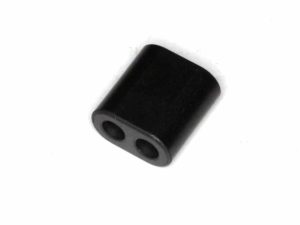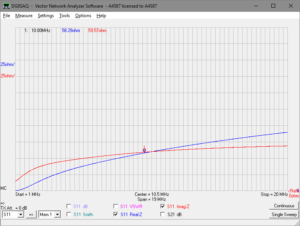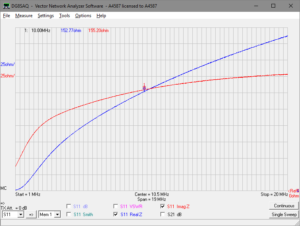Binocular ferrite cores are widely used, but not so widely understood.
Understanding inductors is an important first step to understanding transformers are they are coupled inductors.

The usual use of them is to make a winding of several turns around the central limb. One turn is a pass through both sides of the core around the central limb. Figures given in datasheets for Al or impedance rely upon that meaning of one turn.
A common assumption is that L=Al*n^2.
Note that published Al values are obtained by measurement typically at 10kHz and are not directly applicable at radio frequencies for core materials where the permeability µ is significantly different to µi (most ferrites). Notwithstanding this fact, most inductance calculators assume µ is not frequency dependent.
Let us measure a one turn winding on a practical binocular core for reference

Above is a measurement of R,X of a BN43-202 core with a one turn winding at 10MHz. X is 59.57Ω implying inductance of 0.95µH (assuming a simple two component model which does not capture self resonance effects). Datasheets for this core specify Al as 2200nH for one turn, yet we measure 950nH at 10MHz… proof of problems in simple application of Al.
Of course it is possible to make an inductor by passing a conductor once though one side of the binocular, a half turn if you like, but don’t let that label imply the impedance relative to a one turn winding.

Above is a measurement of a BN43-202 core with a ‘half turn’ winding.
If inductance followed the formula L=Al*n^2 and this was truly a half turn winding, we would expect the inductive reactance X ( 37.16Ω) to be one quarter or 25% of that of the single turn inductor (59.57Ω). Clearly it is not, it is 62%, the notion of a half turn or the formula or both have failed badly in this case.
Well on the back of that failure, lets try 1.5t.
Would we be brave or foolish to predict inductance will be 1.5^2 times that for one turn?

Above is a measurement of a BN43-202 core with a ‘one and a half turn’ winding.
If inductance followed the formula L=Al*n^2 and this was truly a half turn winding, we would expect the inductive reactance X ( 155.2Ω) to be 1.5^2 or 2.25 times that of the single turn inductor (59.57Ω). Clearly it is not, it is 2.60 times, the notion of a half turn or the formula or both have failed badly in this case.
Now let us look at Q, the ratio of X/R. The Q of the half turn inductor is 1.051, the one turn inductor is 1.022, and the one and a half turn inductor is 1.016. The quite small decrease in Q may be entirely due to the lower self resonant frequency as more turns are added and may not indicate a significant increase in core loss because of ‘half turn effects’ as sometimes claimed.
The error in conventional n^2 estimates of odd half turns becomes less significant with higher turns.
Conclusions
The traditional formula L=Al*n^2 does not apply to ferrite binocular cores at radio frequencies for odd half turns, and does not account for variation of permeability with frequency or influence of self resonance.
Understanding inductors is the first step to understanding transformers are they are coupled inductors.
Last update: 28th January, 2017, 8:54 AM











